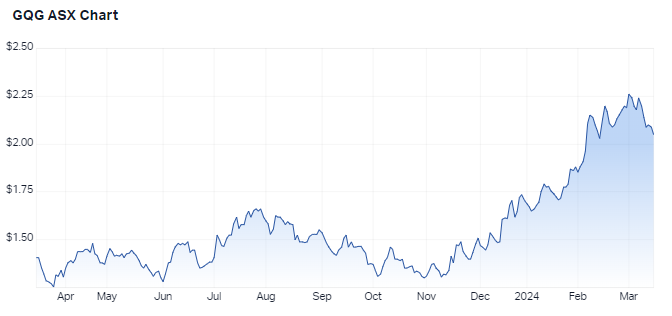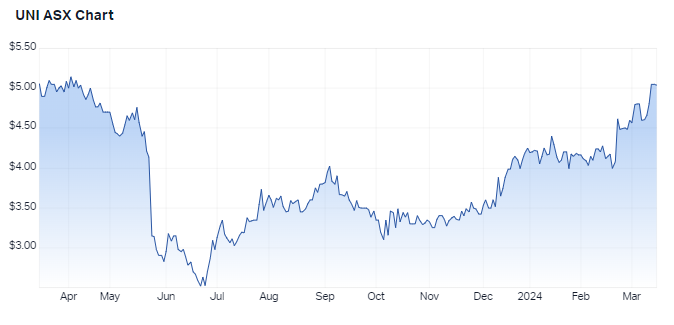Why consistent demand and falling inflation mean the ASX can continue to rally
In the wake of the recent reporting season, I checked in with Michael Carmody from Centennial Asset Management to see how the dust has settled and, more importantly, to understand what he thinks are the key drivers moving forward.
Most importantly, I asked him whether the ASX should be trading at all-time highs. As the headline would suggest, Carmody is bullish on the outlook, noting that with "the next move in interest rates is likely to be down in the 2H of 2024, the macro setting for equities is positive".
Interestingly, Carmody also suggested that the ex-50 universe is the best place to capture outperformance.
Always looking out for Livewire readers, I asked him for a couple of stock ideas that he and the Centennial team likes right now.
.png)
1. Is this as bad as it gets for the consumer?
We don’t think the Australian consumer is in bad shape. The recent reporting season delivered robust demand for a group of quality retailers. JB Hi Fi (ASX: JBH), Super Group (ASX: SUL), Nick Scali (ASX: NCK) and Wesfarmers (ASX: WES) all reported results that were ahead of forecasts.
While there are pockets of stress within the consumer landscape, the overall picture looks robust to us.
The latest ABS data for Jan 2024 was better than expected. The data delivered retail sales growth of +1.1% (year on year) compared to -2.1% in December 2023.
A deterioration in consumer demand this year cannot be ruled out but with the prospect of tax cuts and RBA rate cuts taking place in the 2H of 2024, we see any further deterioration as being modest.
It is important to remember the market is a forward pricing instrument. As a result, we see most of the risks associated with a decline in consumer demand as being largely priced into retail sector valuations.
2. Has the market got it right on interest rates?
The RBA elected to keep rates on hold at 4.35% after the bank’s February meeting. While the RBA hasn’t ruled out rate tightening in 2024, it appears that inflation has now passed its peak and we suspect the next RBA move is a rate cut.
The key question is when?
Quarter 4 GDP was 1.5% versus a year ago, in line with consensus expectations. The data was also consistent with the RBA forecasts. As a result, the RBA’s current interest rate plans are unlikely to change at the next meeting in March.
Most economists expect rates to move lower in the 2H of 2024 and through 2025.
We believe it is logical to assume that the consensus timetable for rate reductions to begin in Q3, 2024 is sensible. In our view, the precise timing of rate cuts in 2024 is not important.
Provided inflation continues to trend towards the target range of 2-3% and the next move in rates is down, we expect the equity market to rally.
3. Was the bar set too low, or are the better-than-expected results a genuine surprise?
The 1H FY24 results were modestly better than expected, with reported earnings mostly exceeding consensus expectations. Surprisingly, despite higher inflation and elevated interest rates, most management teams navigated these challenges well and delivered solid operating results for the first half of FY24.
It does look like expectations were too ‘bearish’ ahead of 1H FY24 reporting period. Operating margins didn’t deteriorate as much as expected during the period and profitability was generally higher compared to market consensus. For example, quality retailers were able to protect gross margins by negotiating manufacturing discounts, particularly from Chinese producers, and company cost-saving initiatives across the market also protected operating margins from decline.
Importantly, while outlook commentary was cautious, most management teams were optimistic regarding demand and the outlook for earnings in the next year.
4. Cost management was a big theme but you can’t cut costs forever – was that a one-shot deal or is there more fat to be trimmed?
In the current environment, management teams will continue to focus on costs and optimise expenditures to protect operating margins and profitability. In a predominantly service-based economy, wage costs will remain a key focus in 2024/25 as the impact of announced increases annualise. However, in the last 12-18 months, most corporates have been able to lock in price increases that have served to somewhat offset cost inflation.
Not surprisingly, Artificial Intelligence (AI) and its forecast impact on costs and productivity was also another major reporting season theme. The opportunity to automate repetitive tasks and streamline data-heavy business processes will undoubtedly contribute to improved cost structures in the future. Quantifying the magnitude and timing of the anticipated cost savings is difficult but management commentary suggests that savings are expected to be material over the long-term.
Lower input cost inflation (transportation/raw materials/energy) from a peak in 2021/2022 reduces the risk of a further decline in operating margins and profitability.
In isolation, costs cannot be cut forever but the risk of a broad-based structural decline in Australian corporate margins appears low.
6. While the results season was better than expected, should the ASX 200 be trading at all-time highs?
Investors always get worried when markets hit all-time highs. It might be stating the obvious but without new all-time highs, the market cannot rally. While there are always arguments on both sides, it is important to recall that markets go up in the long term. Since 1900, the Australian market has delivered a positive yearly return 81% of the time and returned an average of 13.2% per annum.
The market at all-time highs is a sign that investors have confidence in the future and the direction of the economy.
Given that consumption/demand remains consistent, inflation continues to decline and interest rates have stabilised, we believe a recession in Australia is now unlikely. Against that backdrop, the next move in interest rates will likely be down in the 2H of 2024. The macro setting for equities is positive.
While it is hard to argue the market is inexpensive, we expect the index to rise over the next year as corporate earnings recover and investor risk appetite returns.
The market’s performance over the last 12 to 18 months has been dominated by a small number of large-cap stocks. We expect the breadth of the recent share price rally to broaden.
As a result, we would be surprised if the ex-50 universe doesn’t deliver material outperformance.
7. How is Centennial positioning currently?
We have been ‘bullish’ equities, particularly small caps for some time.
As a consequence, the portfolio has been moving capital out of lower risk, less volatile larger companies into our traditional hunting ground, higher growth inexpensive small caps.
Historically, small caps have provided most of the portfolio’s long-term outperformance and we expect the sector to recover in the next 12-24 months after a period of poor shareholder returns.
The reporting season confirmed that consumption/demand in Australia remains solid, and corporate profitability has not been eroded by inflation.
As a result, we plan to add new exposures that are leveraged to both an EPS and ratings recovery. We are looking for the small-cap financial services sector to reverse its recent poor performance as markets re-price improving balance sheets and a return to earnings growth.
We also see opportunities within the building materials sector. Population growth, slowing inflation and government policy are expected to improve the demand/supply imbalance that exists within the housing sector. Recent bids for CSR and Adbri from large international trade buyers reinforce our ‘bullish’ view regarding the outlook for the housing sector.
7. Can you highlight two stocks you like right now?
GQG Partners (ASX: GQG)

GQG recently delivered a strong FY23 result that was slightly ahead of market forecasts. Revenue and net operating income growth was strong (+19%/+16%). Importantly, the result was supported by FUM growth over the year. Post the result, the group’s FUM has continued to grow. The last update recorded total FUM at US$137.5 billion.
We believe GQG has good earnings momentum going into the next year given the strong performance being delivered by the investment strategies being employed by the company. As a result, we expect FUM and earnings to continue to grow and see current market expectations as being conservative.
With inflation in decline and the potential for interest rate cuts in the 2H of 2024, we would expect GQG to outperform. The valuation appears inexpensive relative to forecast FUM and earnings growth. In a recovering market, we like to own companies with the potential to not only beat earnings forecasts but also to re-rate. We see GQG as being ideally placed to do both.
Universal Store Holdings (ASX: UNI)

Despite cost-of-living pressures, quality retailers delivered surprisingly strong results for the 1H FY24. UNI was a standout performer in the results period.
Despite a strong performance in the previous corresponding period (PCP), UNI delivered sales growth of +8.5% and a gross profit margin expansion of +80 basis points. Lower-than-expected wage growth and a better cost of goods sold result also contributed to the 1H FY24 result.
Importantly, trading in January and February has started well with the group’s dominant retail brands delivering positive comps. We thought the turnaround in like-for-like (LFL) sales in the first seven weeks of trading in 2H FY24 was impressive (+1.0% vs -8.0%). In addition, UNI is expected to continue the rollout of new stores in the 2H FY24.
Provided labour optimisation and manufacturing deflation continue as expected, UNI is well positioned to deliver upside earnings surprise versus consensus in FY24. The UNI management team is managing the challenging operating environment well. We believe consensus expectations look conservative and the valuation attractive.
2 topics
6 stocks mentioned
1 contributor mentioned

